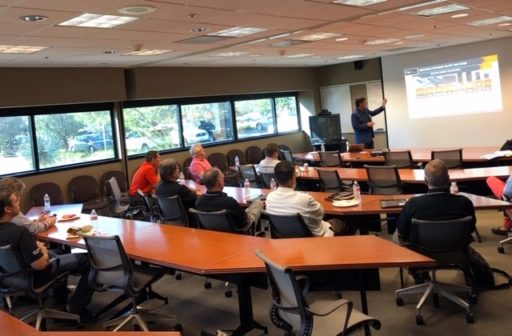Hitting the Road for Edge Data Centers
Last month, DSI partnered with Future Facilities and RF Code to host two Edge Data Center seminars. The first one was held at Hurricane Electric’s Fremont 2 data center in Fremont, CA and the other one was held in Irvine, CA at Southern California Edison’s operations center. Upon conclusion of the Irvine event, attendees had the opportunity to tour SCE’s data center and get some tips from its data center manager, who reported that the site has never experienced downtime in its thirty plus year history.
During the presentations, each company laid out what they each bring to Edge and Modular Data Centers. DSI took the stage first, highlighting the process for the proper design and construction of Edge and Modular Data Centers and detailing how quickly these systems can be online. To highlight this, DSI discussed how its team of experts were able to design and construct a modular data center for a large University saving the client time and money by fast tracking the project. DSI went on to highlight that a Modular Data Center’s upfront cost can be 20-30% less to build than a traditional data center facility, when considering that modular solutions do not need to be oversized in anticipation of future growth, and the site can be configured to enable adding future modules as the business requires. Additionally, with Modular Data Centers the individual components and manufacturing process is standardized saving time. To learn more about DSI’s approach to Modular and Edge, check out Phil Rafferty’s article at Facility Executive.
Once you have built a Modular or Edge Data Center, how do you ensure seamless operations in these unstaffed microsites? This is where RF Code comes in. Recently launching their RF Code for Edge product, Trey Evans of RF Code reminded the audience how important visibility is in these highly distributed and difficult to monitor facilities. RF Code helps Edge operators meet the monitoring and management challenges with the ability to intelligently address operational risks, reduce costs, and ensure regulatory compliance.
Future Facilities tied all of this together with their talk on the ‘Digital Twin’ and being able make changes to the existing data center through a virtual model, enabling the end-user to see what the effects will be before the hardware is physically deployed in the data center. According to Future Facilities, over provisioning in data centers is a huge problem with operators building three data centers for every two they need. This equates to a lot of investment in extra capacity that may never get used.
To wrap up the seminar, Tod Sward of SCE took the podium to displace some of the apprehension about building data centers in Southern California. Tod highlighted some of the robust economic incentives that the company is offering. For example, companies with a minimum load of 150 kW, the energy discount program offers 12% on energy bills over five years.
If you have interest in attending one of our upcoming shows, please reach out, as we plan take our Edge Data Center discussion to other cities.





